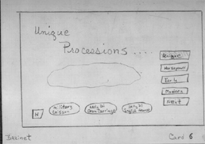 {click on the image to view it at a larger size}
{click on the image to view it at a larger size}
What is the purpose of the storyboard? The purpose of the storyboard for the designer to determine a logical format for the information to be presented in the multimedia project. This means that the designer will make critical decisions during the storyboarding process, including how information is to be grouped and how specific information is to be represented. Further, navigational decisions will also be made based on the organization of the information.
What if my initial ideas change through the production of my project? That's OK, and the storyboarding process is still valuable. The difference in this case between doing a storyboard and not doing a storyboard is that changes later on are changes from one idea to another, versus the case where no storyboard has been completed, in which case changes are changes from nothing to something. In most cases changes in the former case are given more careful and thoughtful consideration, leading to a better project. The bottom line is that the process of developing the storyboard is extremely valuable, even if things change as the project develops.
How many buttons should I have on a page? If at all possible, you should have no more buttons on the page than someone using the program could comfortably compare and contrast. Fundamentally, the user is discriminating (making a judgment) regarding which button is the most appropriate for them to pick. While there is some contention over whether or not the 7 +/-2 rule (the amount of information one can maintain in short term memory) is useful as a rule in this case, what can safely be said is that you don't want to overwhelm the user with too many buttons (and information for that matter). Keep the number of buttons low, usually 5 or less. Some possible exceptions are if you use groups of buttons or roll-over buttons. In either of these cases the information is chunked, and is more manageable for the user.
What about an exit button, where do I put it? Typically the exit button is placed on the main menu card (all projects should have some sort of main menu). It usually goes in a corner of the main menu card, in the exact location that the home button is placed on all other cards. The exit button should be scripted with a trapdoor, so that the user can select to leave or not to leave.
What about a home button, what pages have that? The home button is placed on all pages in the project, in the exact same location, usually a corner. This will bring the user to the main menu from anywhere at anytime. Some designers recommend that there also be an exit button on every card, but the home button, being placed in the exact same relative location as the exit button, serves this purpose (two clicks in the location of the main menu and they can leave the stack, from anywhere).
This page created 10/25/99 by Dr.
Anthony K. Betrus. Last updated 03/07/2004.